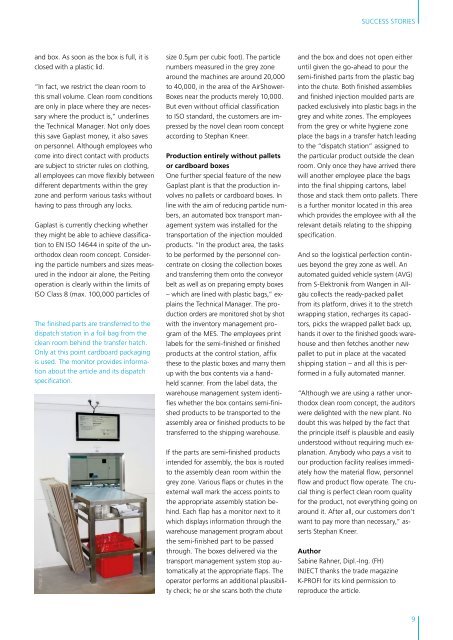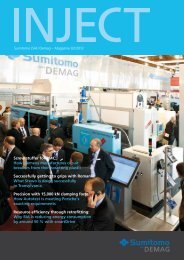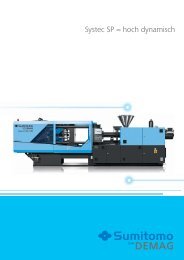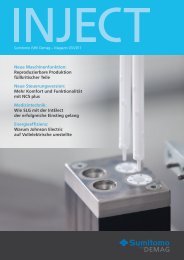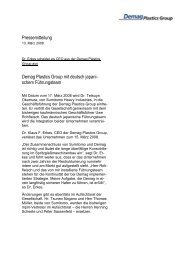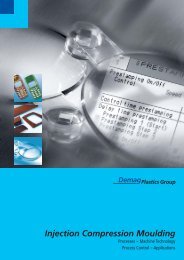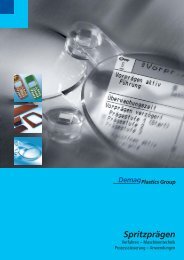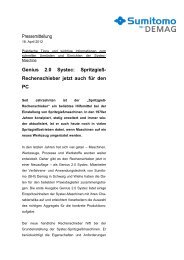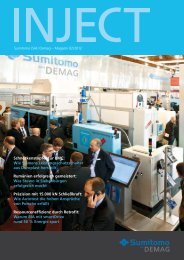4690_Inject_1_2013_en_130710.pdfDownload - Sumitomo (SHI ...
4690_Inject_1_2013_en_130710.pdfDownload - Sumitomo (SHI ...
4690_Inject_1_2013_en_130710.pdfDownload - Sumitomo (SHI ...
You also want an ePaper? Increase the reach of your titles
YUMPU automatically turns print PDFs into web optimized ePapers that Google loves.
SUCCESS STORIES<br />
and box. As soon as the box is full, it is<br />
closed with a plastic lid.<br />
“In fact, we restrict the clean room to<br />
this small volume. Clean room conditions<br />
are only in place where they are necessary<br />
where the product is,” underlines<br />
the Technical Manager. Not only does<br />
this save Gaplast money, it also saves<br />
on personnel. Although employees who<br />
come into direct contact with products<br />
are subject to stricter rules on clothing,<br />
all employees can move flexibly betwe<strong>en</strong><br />
differ<strong>en</strong>t departm<strong>en</strong>ts within the grey<br />
zone and perform various tasks without<br />
having to pass through any locks.<br />
Gaplast is curr<strong>en</strong>tly checking whether<br />
they might be able to achieve classification<br />
to EN ISO 14644 in spite of the unorthodox<br />
clean room concept. Considering<br />
the particle numbers and sizes measured<br />
in the indoor air alone, the Peiting<br />
operation is clearly within the limits of<br />
ISO Class 8 (max. 100,000 particles of<br />
The finished parts are transferred to the<br />
dispatch station in a foil bag from the<br />
clean room behind the transfer hatch.<br />
Only at this point cardboard packaging<br />
is used. The monitor provides information<br />
about the article and its dispatch<br />
specification.<br />
Photo: K -PROFI<br />
size 0.5μm per cubic foot). The particle<br />
numbers measured in the grey zone<br />
around the machines are around 20,000<br />
to 40,000, in the area of the AirShower-<br />
Boxes near the products merely 10,000.<br />
But ev<strong>en</strong> without official classification<br />
to ISO standard, the customers are impressed<br />
by the novel clean room concept<br />
according to Stephan Kneer.<br />
Production <strong>en</strong>tirely without pallets<br />
or cardboard boxes<br />
One further special feature of the new<br />
Gaplast plant is that the production involves<br />
no pallets or cardboard boxes. In<br />
line with the aim of reducing particle numbers,<br />
an automated box transport managem<strong>en</strong>t<br />
system was installed for the<br />
transportation of the injection moulded<br />
products. “In the product area, the tasks<br />
to be performed by the personnel conc<strong>en</strong>trate<br />
on closing the collection boxes<br />
and transferring them onto the conveyor<br />
belt as well as on preparing empty boxes<br />
– which are lined with plastic bags,” explains<br />
the Technical Manager. The production<br />
orders are monitored shot by shot<br />
with the inv<strong>en</strong>tory managem<strong>en</strong>t program<br />
of the MES. The employees print<br />
labels for the semi-finished or finished<br />
products at the control station, affix<br />
these to the plastic boxes and marry them<br />
up with the box cont<strong>en</strong>ts via a handheld<br />
scanner. From the label data, the<br />
warehouse managem<strong>en</strong>t system id<strong>en</strong>tifies<br />
whether the box contains semi-finished<br />
products to be transported to the<br />
assembly area or finished products to be<br />
transferred to the shipping warehouse.<br />
If the parts are semi-finished products<br />
int<strong>en</strong>ded for assembly, the box is routed<br />
to the assembly clean room within the<br />
grey zone. Various flaps or chutes in the<br />
external wall mark the access points to<br />
the appropriate assembly station behind.<br />
Each flap has a monitor next to it<br />
which displays information through the<br />
warehouse managem<strong>en</strong>t program about<br />
the semi-finished part to be passed<br />
through. The boxes delivered via the<br />
transport managem<strong>en</strong>t system stop automatically<br />
at the appropriate flaps. The<br />
operator performs an additional plausibility<br />
check; he or she scans both the chute<br />
and the box and does not op<strong>en</strong> either<br />
until giv<strong>en</strong> the go-ahead to pour the<br />
semi-finished parts from the plastic bag<br />
into the chute. Both finished assemblies<br />
and finished injection moulded parts are<br />
packed exclusively into plastic bags in the<br />
grey and white zones. The employees<br />
from the grey or white hygi<strong>en</strong>e zone<br />
place the bags in a transfer hatch leading<br />
to the “dispatch station” assigned to<br />
the particular product outside the clean<br />
room. Only once they have arrived there<br />
will another employee place the bags<br />
into the final shipping cartons, label<br />
those and stack them onto pallets. There<br />
is a further monitor located in this area<br />
which provides the employee with all the<br />
relevant details relating to the shipping<br />
specification.<br />
And so the logistical perfection continues<br />
beyond the grey zone as well. An<br />
automated guided vehicle system (AVG)<br />
from S-Elektronik from Wang<strong>en</strong> in Allgäu<br />
collects the ready-packed pallet<br />
from its platform, drives it to the stretch<br />
wrapping station, recharges its capacitors,<br />
picks the wrapped pallet back up,<br />
hands it over to the finished goods warehouse<br />
and th<strong>en</strong> fetches another new<br />
pallet to put in place at the vacated<br />
shipping station – and all this is performed<br />
in a fully automated manner.<br />
“Although we are using a rather unorthodox<br />
clean room concept, the auditors<br />
were delighted with the new plant. No<br />
doubt this was helped by the fact that<br />
the principle itself is plausible and easily<br />
understood without requiring much explanation.<br />
Anybody who pays a visit to<br />
our production facility realises immediately<br />
how the material flow, personnel<br />
flow and product flow operate. The crucial<br />
thing is perfect clean room quality<br />
for the product, not everything going on<br />
around it. After all, our customers don’t<br />
want to pay more than necessary,” asserts<br />
Stephan Kneer.<br />
Author<br />
Sabine Rahner, Dipl.-Ing. (FH)<br />
INJECT thanks the trade magazine<br />
K-PROFI for its kind permission to<br />
reproduce the article.<br />
9


